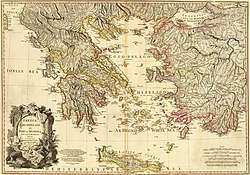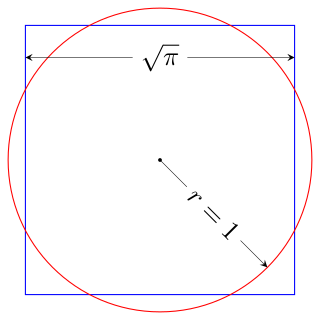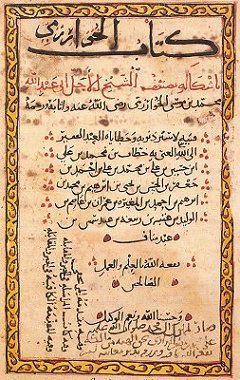This is a timeline of mathematicians in ancient Greece .
Contents
- Timeline
- Overview of the most important mathematicians and discoveries
- Hellenic mathematicians
- Straightedge and compass constructions
- Algebra
- See also
- References
| History of Greece |
|---|
 |
This is a timeline of mathematicians in ancient Greece .
| History of Greece |
|---|
 |
Historians traditionally place the beginning of Greek mathematics proper to the age of Thales of Miletus (ca. 624–548 BC), which is indicated by the green line at 600 BC. The orange line at 300 BC indicates the approximate year in which Euclid's Elements was first published. The red line at 300 AD passes through Pappus of Alexandria (c. 290 – c. 350 AD), who was one of the last great Greek mathematicians of late antiquity. Note that the solid thick black line is at year zero, which is a year that does not exist in the Anno Domini (AD) calendar year system
 |
The mathematician Heliodorus of Larissa is not listed due to the uncertainty of when he lived, which was possibly during the 3rd century AD, after Ptolemy.
Of these mathematicians, those whose work stands out include:
The conquests of Alexander the Great around c. 330 BC led to Greek culture being spread around much of the Mediterranean region, especially in Alexandria, Egypt. This is why the Hellenistic period of Greek mathematics is typically considered as beginning in the 4th century BC. During the Hellenistic period, many people living in those parts of the Mediterranean region subject to Greek influence ended up adopting the Greek language and sometimes also Greek culture. Consequently, some of the Greek mathematicians from this period may not have been "ethnically Greek" with respect to the modern Western notion of ethnicity, which is much more rigid than most other notions of ethnicity that existed in the Mediterranean region at the time. Ptolemy, for example, was said to have originated from Upper Egypt, which is far South of Alexandria, Egypt. Regardless, their contemporaries considered them Greek.

For the most part, straightedge and compass constructions dominated ancient Greek mathematics and most theorems and results were stated and proved in terms of geometry. These proofs involved a straightedge (such as that formed by a taut rope), which was used to construct lines, and a compass, which was used to construct circles. The straightedge is an idealized ruler that can draw arbitrarily long lines but (unlike modern rulers) it has no markings on it. A compass can draw a circle starting from two given points: the center and a point on the circle. A taut rope can be used to physically construct both lines (since it forms a straightedge) and circles (by rotating the taut rope around a point).
Geometric constructions using lines and circles were also used outside of the Mediterranean region. The Shulba Sutras from the Vedic period of Indian mathematics, for instance, contains geometric instructions on how to physically construct a (quality) fire-altar by using a taut rope as a straightedge. These alters could have various shapes but for theological reasons, they were all required to have the same area. This consequently required a high precision construction along with (written) instructions on how to geometrically construct such alters with the tools that were most widely available throughout the Indian subcontinent (and elsewhere) at the time. Ancient Greek mathematicians went one step further by axiomatizing plane geometry in such a way that straightedge and compass constructions became mathematical proofs. Euclid's Elements was the culmination of this effort and for over two thousand years, even as late as the 19th century, it remained the "standard text" on mathematics throughout the Mediterranean region (including Europe and the Middle East), and later also in North and South America after European colonization.
Ancient Greek mathematicians are known to have solved specific instances of polynomial equations with the use of straightedge and compass constructions, which simultaneously gave a geometric proof of the solution's correctness. Once a construction was completed, the answer could be found by measuring the length of a certain line segment (or possibly some other quantity). A quantity multiplied by itself, such as for example, would often be constructed as a literal square with sides of length which is why the second power "" is referred to as " squared" in ordinary spoken language. Thus problems that would today be considered "algebra problems" were also solved by ancient Greek mathematicians, although not in full generality. A complete guide to systematically solving low-order polynomials equations for an unknown quantity (instead of just specific instances of such problems) would not appear until The Compendious Book on Calculation by Completion and Balancing by Muhammad ibn Musa al-Khwarizmi, who used Greek geometry to "prove the correctness" of the solutions that were given in the treatise. However, this treatise was entirely rhetorical (meaning that everything, including numbers, was written using words structured in ordinary sentences) and did not have any "algebraic symbols" that are today associated with algebra problems – not even the syncopated algebra that appeared in Arithmetica .

Euclid was an ancient Greek mathematician active as a geometer and logician. Considered the "father of geometry", he is chiefly known for the Elements treatise, which established the foundations of geometry that largely dominated the field until the early 19th century. His system, now referred to as Euclidean geometry, involved new innovations in combination with a synthesis of theories from earlier Greek mathematicians, including Eudoxus of Cnidus, Hippocrates of Chios, Thales and Theaetetus. With Archimedes and Apollonius of Perga, Euclid is generally considered among the greatest mathematicians of antiquity, and one of the most influential in the history of mathematics.

Euclidean geometry is a mathematical system attributed to ancient Greek mathematician Euclid, which he described in his textbook on geometry, Elements. Euclid's approach consists in assuming a small set of intuitively appealing axioms (postulates) and deducing many other propositions (theorems) from these. Although many of Euclid's results had been stated earlier, Euclid was the first to organize these propositions into a logical system in which each result is proved from axioms and previously proved theorems.

Geometry arose as the field of knowledge dealing with spatial relationships. Geometry was one of the two fields of pre-modern mathematics, the other being the study of numbers (arithmetic).

The history of mathematics deals with the origin of discoveries in mathematics and the mathematical methods and notation of the past. Before the modern age and the worldwide spread of knowledge, written examples of new mathematical developments have come to light only in a few locales. From 3000 BC the Mesopotamian states of Sumer, Akkad and Assyria, followed closely by Ancient Egypt and the Levantine state of Ebla began using arithmetic, algebra and geometry for purposes of taxation, commerce, trade and also in the patterns in nature, the field of astronomy and to record time and formulate calendars.

In geometry, straightedge-and-compass construction – also known as ruler-and-compass construction, Euclidean construction, or classical construction – is the construction of lengths, angles, and other geometric figures using only an idealized ruler and a pair of compasses.

Doubling the cube, also known as the Delian problem, is an ancient geometric problem. Given the edge of a cube, the problem requires the construction of the edge of a second cube whose volume is double that of the first. As with the related problems of squaring the circle and trisecting the angle, doubling the cube is now known to be impossible to construct by using only a compass and straightedge, but even in ancient times solutions were known that employed other methods.

Squaring the circle is a problem in geometry first proposed in Greek mathematics. It is the challenge of constructing a square with the area of a given circle by using only a finite number of steps with a compass and straightedge. The difficulty of the problem raised the question of whether specified axioms of Euclidean geometry concerning the existence of lines and circles implied the existence of such a square.
The timeline below shows the date of publication of possible major scientific breakthroughs, theories and discoveries, along with the discoverer. This article discounts mere speculation as discovery, although imperfect reasoned arguments, arguments based on elegance/simplicity, and numerically/experimentally verified conjectures qualify. The timeline begins at the Bronze Age, as it is difficult to give even estimates for the timing of events prior to this, such as of the discovery of counting, natural numbers and arithmetic.

Al-Jabr, also known as The Compendious Book on Calculation by Completion and Balancing, is an Arabic mathematical treatise on algebra written in Baghdad around 820 by the Persian polymath Al-Khwarizmi. It was a landmark work in the history of mathematics, with its title being the ultimate etymology of the word "algebra" itself, later borrowed into Medieval Latin as algebrāica.

Greek mathematics refers to mathematics texts and ideas stemming from the Archaic through the Hellenistic and Roman periods, mostly from the 5th century BC to the 6th century AD, around the shores of the Mediterranean. Greek mathematicians lived in cities spread over the entire region, from Anatolia to Italy and North Africa, but were united by Greek culture and the Greek language. The development of mathematics as a theoretical discipline and the use of deductive reasoning in proofs is an important difference between Greek mathematics and those of preceding civilizations.
In mathematics, particularly in geometry, quadrature is a historical process of drawing a square with the same area as a given plane figure or computing the numerical value of that area. A classical example is the quadrature of the circle . Quadrature problems served as one of the main sources of problems in the development of calculus. They introduce important topics in mathematical analysis.

Arithmetica is an Ancient Greek text on mathematics written by the mathematician Diophantus in the 3rd century AD. It is a collection of 130 algebraic problems giving numerical solutions of determinate equations and indeterminate equations.

Mathematics during the Golden Age of Islam, especially during the 9th and 10th centuries, was built on Greek mathematics and Indian mathematics. Important progress was made, such as full development of the decimal place-value system to include decimal fractions, the first systematised study of algebra, and advances in geometry and trigonometry.
The history of mathematical notation includes the commencement, progress, and cultural diffusion of mathematical symbols and the conflict of the methods of notation confronted in a notation's move to popularity or inconspicuousness. Mathematical notation comprises the symbols used to write mathematical equations and formulas. Notation generally implies a set of well-defined representations of quantities and symbols operators. The history includes Hindu–Arabic numerals, letters from the Roman, Greek, Hebrew, and German alphabets, and a host of symbols invented by mathematicians over the past several centuries.
Algebra can essentially be considered as doing computations similar to those of arithmetic but with non-numerical mathematical objects. However, until the 19th century, algebra consisted essentially of the theory of equations. For example, the fundamental theorem of algebra belongs to the theory of equations and is not, nowadays, considered as belonging to algebra.
The following is a timeline of key developments of algebra:
Geometry is a branch of mathematics concerned with properties of space such as the distance, shape, size, and relative position of figures. Geometry is, along with arithmetic, one of the oldest branches of mathematics. A mathematician who works in the field of geometry is called a geometer. Until the 19th century, geometry was almost exclusively devoted to Euclidean geometry, which includes the notions of point, line, plane, distance, angle, surface, and curve, as fundamental concepts.
The following is a timeline of key developments of geometry:
This is a timeline of pure and applied mathematics history. It is divided here into three stages, corresponding to stages in the development of mathematical notation: a "rhetorical" stage in which calculations are described purely by words, a "syncopated" stage in which quantities and common algebraic operations are beginning to be represented by symbolic abbreviations, and finally a "symbolic" stage, in which comprehensive notational systems for formulas are the norm.
The Ancient Tradition of Geometric Problems is a book on ancient Greek mathematics, focusing on three problems now known to be impossible if one uses only the straightedge and compass constructions favored by the Greek mathematicians: squaring the circle, doubling the cube, and trisecting the angle. It was written by Wilbur Knorr (1945–1997), a historian of mathematics, and published in 1986 by Birkhäuser. Dover Publications reprinted it in 1993.
Archimedes is on most lists of the greatest mathematicians of all time and is considered the greatest mathematician of antiquity.
Archimedes was the greatest mathematician of antiquity and one of the greatest of all times